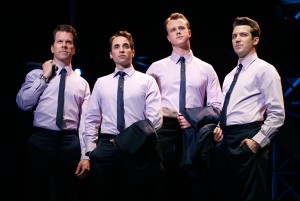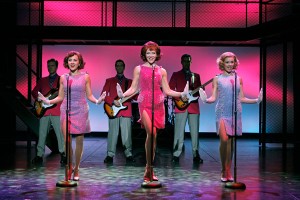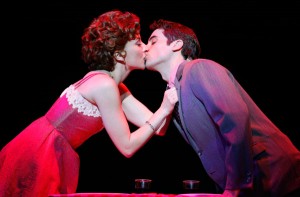THE BOYS ARE BACK, AND BETTER THAN EVER
Maybe it’s the law of averages. Put enough jukebox musicals on the American stage and one of them is bound to come up a classic. That may explain the hit status of Jersey Boys, the musical inspired by the male quartet Frankie Valli and the Four Seasons back in the 1960’s. But that implies an element of luck in the show’s success. There is nothing lucky about the brilliance of Jersey Boys. The show triumphs because of a superior staging and strong book that complement some of the most listenable pop/rock music of the last half century. The musical installed itself as one of the longest running hits in Chicago theater history from 2007 to 2010. Now the show is back for a nine-week run, and it’s as superb as ever, which is just about as good as it gets.
 Jersey Boys recounts the lives and music of four young Italian-Americans, three of whom grew up on the mean urban streets of Newark, New Jersey, where, as one of the narrators comments, a young man had three ways out of the neighborhood – join the army, get mobbed up, or become a pop music star. And so it was with Frankie Valli, Tommy DeVito, and Nick Massi. Bob Gaudio, the fourth member of the Four Seasons, arrived by a slightly different route, voted in for his genius as a songwriter.
Jersey Boys recounts the lives and music of four young Italian-Americans, three of whom grew up on the mean urban streets of Newark, New Jersey, where, as one of the narrators comments, a young man had three ways out of the neighborhood – join the army, get mobbed up, or become a pop music star. And so it was with Frankie Valli, Tommy DeVito, and Nick Massi. Bob Gaudio, the fourth member of the Four Seasons, arrived by a slightly different route, voted in for his genius as a songwriter.

The first act traces Valli, Massi, DeVito, and Gaudio as they struggle to make it in the highly competitive world of pop music in the early 1960’s. After going through one identity crisis after another, the group exploded on the national music scene in 1962 with Gaudio’s song Sherry that cemented the distinctive group sound dominated by Valli’s expressive high-pitched voice. When the group suddenly launched Sherry halfway through the opening act you could feel the electricity shoot through the audience. It must have been at this juncture that the Broadway producers back in 2005 realized they had a monster hit on their hands.
 The first act is all about how the Four Seasons made it big. The second act focuses on Valli and his personal problems as well as his music. The group, stressed by personality conflicts almost from the beginning, breaks up and Valli has a tragedy occur within his family. The show ends decades after the breakup with the group’s induction into the Rock and Roll Hall of Fame and each singer’s personal farewell to the audience.
The first act is all about how the Four Seasons made it big. The second act focuses on Valli and his personal problems as well as his music. The group, stressed by personality conflicts almost from the beginning, breaks up and Valli has a tragedy occur within his family. The show ends decades after the breakup with the group’s induction into the Rock and Roll Hall of Fame and each singer’s personal farewell to the audience.
 The storyline is enriched by its multiple narrations. Each of the Four Seasons gives his slant on how the group came about, reached the top of the music charts, and then disbanded. The angle of vision changes with each interpretation, giving the book a Rashomon quality of truth being in the eye of the beholder.
The storyline is enriched by its multiple narrations. Each of the Four Seasons gives his slant on how the group came about, reached the top of the music charts, and then disbanded. The angle of vision changes with each interpretation, giving the book a Rashomon quality of truth being in the eye of the beholder.
The ensemble consists of more than 20 performers, most of them taking on multiple roles (with multiple costume changes that must have created a controlled frenzy backstage). The stars carry the show, none brighter than Joseph Leo Bwarie as Frankie Valli. Bwarie has Valli’s diminutive stature, looks like him facially, and most critically, he has Valli’s vocal style down pat, with the singing range that rises into the falsetto stratosphere. It’s a hugely demanding role and Bwarie takes a breather at some matinees, replaced by Nick Cosgrove.
 John Gardiner delivers a dominating performance as Tommy DeVito, the headstrong and conniving founder of the Four Seasons (or so he claims) whose reckless financial dealings get him in big trouble with the mob and help sink the Four Seasons. Michael Lomenda plays the rather doofus Nick Massi and Preston Truman Boyd is Bob Gaudio, the creative genius behind the Four Season’s success. Jonathan Hadley has some fine comic moments as swishy record producer and lyricist Bob Crewe who helps lead the group to the musical Promised Land. Kara Tremel is first rate as Mary Delgado, the brassy girl from the Newark ’˜hood who learns the hard way that it’s tough to be married to a traveling entertainer.
John Gardiner delivers a dominating performance as Tommy DeVito, the headstrong and conniving founder of the Four Seasons (or so he claims) whose reckless financial dealings get him in big trouble with the mob and help sink the Four Seasons. Michael Lomenda plays the rather doofus Nick Massi and Preston Truman Boyd is Bob Gaudio, the creative genius behind the Four Season’s success. Jonathan Hadley has some fine comic moments as swishy record producer and lyricist Bob Crewe who helps lead the group to the musical Promised Land. Kara Tremel is first rate as Mary Delgado, the brassy girl from the Newark ’˜hood who learns the hard way that it’s tough to be married to a traveling entertainer.
 Director Des McAnuff and choreographer Sergio Trujillo combine to give the production its energy and seamless narrative progression. The story moves with such pace and inevitability that the viewer might not recognize how beautifully the show is staged, with each scene dovetailing into the next with the unobtrusive exit and entrance of props propelled by members of the ensemble.
Director Des McAnuff and choreographer Sergio Trujillo combine to give the production its energy and seamless narrative progression. The story moves with such pace and inevitability that the viewer might not recognize how beautifully the show is staged, with each scene dovetailing into the next with the unobtrusive exit and entrance of props propelled by members of the ensemble.
 The staging features the skillful use of metal stairs leading to a balcony-like gangway that stretches across the rear of the stage. Projections of illustrations that resemble Roy Lichtenstein comic strip panels enliven the show’s visual impact, along with the dramatic lighting. The design brain trust of Klara Ziegerova (sets), Howell Binkley (lighting), Steve Canyon Kennedy (sound), Michael Clark (projections), and Jess Goldstein (costumes) can take a deep collective bow.
The staging features the skillful use of metal stairs leading to a balcony-like gangway that stretches across the rear of the stage. Projections of illustrations that resemble Roy Lichtenstein comic strip panels enliven the show’s visual impact, along with the dramatic lighting. The design brain trust of Klara Ziegerova (sets), Howell Binkley (lighting), Steve Canyon Kennedy (sound), Michael Clark (projections), and Jess Goldstein (costumes) can take a deep collective bow.
The real heroes of Jersey Boys are Marshall Brickman and Rick Elice, who created a book that is funny, dramatic, informative, and engrossing. Their work allows this fiercely enjoyable show to transcend the conventions of the jukebox musical and join the ranks of the very best musicals of the new millennium. The audience may enter the theater expecting to rely on Sherry, Big Girls Don’t Cry, Walk Like a Man, Rag Doll, and Can’t Take My Eyes Off of You for the evening’s entertainment; indeed, the music is great, but the story behind the music is greater.
photos by Joan Marcus
Jersey Boys
Bank of American Theatre in Chicago
scheduled to end on June 3, 2012
for tickets, call 800 775 2000 or visit http://www.BroadwayInChicago.com
National Tour continues through June 23, 2013; for dates and tickets, visit http://www.jerseyboysinfo.com/tour/
for info on this and other Chicago Theater, visit http://TheatreinChicago.com

